
Gentrification is the process of changing the character of a neighborhood through the influx of more affluent residents and investment. There is no agreed-upon definition of gentrification. In public discourse, it has been used to describe a wide array of phenomena, usually in a pejorative connotation.

The Loop, one of Chicago's 77 designated community areas, is the central business district of the city and is the main section of Downtown Chicago. Home to Chicago's commercial core, it is the second largest commercial business district in North America after Midtown Manhattan in New York City, and contains the headquarters and regional offices of several global and national businesses, retail establishments, restaurants, hotels, and theaters, as well as many of Chicago's most famous attractions. It is home to Chicago's City Hall, the seat of Cook County, and numerous offices of other levels of government and consulates of foreign nations. The intersection of State Street and Madison Street is the origin point for the address system on Chicago's street grid. Most of Grant Park's 319 acres are in the eastern section of the community area. The Loop community area is bounded on the north and west by the Chicago River, on the east by Lake Michigan, and on the south by Roosevelt Road.

Urban renewal is a program of land redevelopment often used to address urban decay in cities. Urban renewal involves the clearing out of blighted areas in inner cities to clear out slums and create opportunities for higher class housing, businesses, and other developments. In the United States the term technically refers only to a federal program in the middle-to-late 20th Century, but colloquially is sometimes used to refer to any large-scale change in urban development.
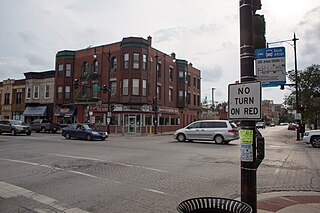
Bridgeport is one of the 77 community areas in Chicago, on the city's South Side, bounded on the north by the South Branch of the Chicago River, on the west by Bubbly Creek, on the south by Pershing Road, and on the east by the Union Pacific railroad tracks. Neighboring communities are Pilsen across the river to the north, McKinley Park to the west, Canaryville to the south, and Armour Square to the east. Bridgeport has been the home of five Chicago mayors. Once known for its racial intolerance, Bridgeport today ranks as one of the city's most diverse neighborhoods.
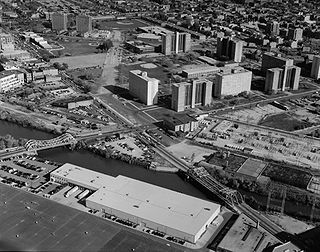
Cabrini–Green Homes was a Chicago Housing Authority (CHA) public housing project on the Near North Side of Chicago, Illinois. The Frances Cabrini Rowhouses and Extensions were south of Division Street, bordered by Larrabee Street to the west, Orleans Street to the east and Chicago Avenue to the south, with the William Green Homes to the northwest.

The Near South Side is a community area of Chicago, Illinois, United States, just south of the downtown central business district, the Loop. The Near South Side's boundaries are as follows: North—Roosevelt Road ; South—26th Street; West—Chicago River between Roosevelt and 18th Street, Clark Street between 18th Street and Cermak Road, Federal between Cermak Road and the Stevenson Expressway just south of 25th Street, and Clark Street again between the Stevenson and 26th Street; and East—Lake Michigan.

Lower West Side is a community area on the West Side of Chicago, Illinois, United States. It is three miles southwest of the Chicago Loop and its main neighborhood is Pilsen. The Heart of Chicago is a neighborhood in the southwest corner of the Lower West Side.

Garfield Ridge is the 56th of Chicago's 77 community areas. Located 10 miles (16 km) from the Loop, it is on the city's far southwest side. As of 2017, the area had 36,396 inhabitants.

Little Italy, sometimes combined with University Village into one neighborhood, is on the Near West Side of Chicago, Illinois. The current boundaries of Little Italy are Ashland Avenue on the west and Interstate 90/94 on the east, the Eisenhower Expressway on the north and Roosevelt to the south. It lies between the east side of the University of Illinois at Chicago campus in the Illinois Medical District and the west side of the University of Illinois at Chicago campus. The community was once predominantly Italian immigrants but now is made up of diverse ethnic and socio-economic backgrounds as a result of immigration, urban renewal, gentrification and the growth of the resident student and faculty population of the University of Illinois at Chicago (UIC). Its Italian-American heritage is primarily evident in the Italian-American restaurants that once lined Taylor Street. The neighborhood is home to the National Italian American Sports Hall of Fame as well as the historic Roman Catholic churches Our Lady of Pompeii, Notre Dame de Chicago, and Holy Family.
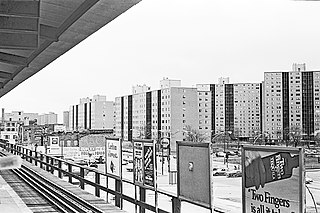
Stateway Gardens was a Chicago Housing Authority (CHA) public housing project located in the Bronzeville neighborhood on the South Side of Chicago, Illinois.

Liberty Square is a 753-unit Miami-Dade public housing apartment complex in the Liberty City neighborhood of Miami, Florida. It is bordered at Martin Luther King Jr. Boulevard/North 62nd Street to the south, North 67th Street to the north, State Road 933 to the east, and Northwest 15th Avenue to the west. Constructed as a part of the New Deal by the Public Works Administration and opening in 1937, it was the first public housing project for African Americans in the Southern United States.
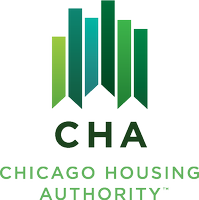
The Chicago Housing Authority (CHA) is a municipal corporation that oversees public housing within the city of Chicago. The agency's Board of Commissioners is appointed by the city's mayor, and has a budget independent from that of the city of Chicago. CHA is the largest rental landlord in Chicago, with more than 50,000 households. CHA owns over 21,000 apartments. It also oversees the administration of 37,000 Section 8 vouchers. The current acting CEO of the Chicago Housing Authority is Tracey Scott.

The Prairie Avenue District is a historic district in the Near South Side community area of Chicago, Illinois. It includes the 1800 and 1900 blocks of South Prairie Avenue and the 1800 block of South Indiana, and 211-217 East Cullerton. It was the site of the Battle of Fort Dearborn and became the city's most fashionable residential district after the Great Chicago Fire. It was designated a Chicago Landmark on December 27, 1979. The district was added to the National Register of Historic Places on November 15, 1972. The John J. Glessner House, designed and built by Henry Hobson Richardson in 1885–1886 at 1800 S. Prairie Avenue, has been restored as a historic house museum, and is open for public tours. In 2006, the Prairie District Neighborhood Alliance, a non-profit organization was formed to provide representation for thousands of South Loop residents, including the Prairie Avenue District, Central Station, Museum Park, Motor Row, and the South Michigan Avenue Corridor, as well as other areas of the Near South Side.
Planning and development in Detroit since the late 20th century has attempted to enhance the economy and quality of life of Detroit, Michigan, United States. In 1970, the private group Detroit Renaissance began to facilitate development in the city. Its successor, Business Leaders for Michigan, has continued to facilitate development into the 21st century. Projects have included new commercial facilities, revitalization of neighborhoods, hospitality infrastructure, and improvements to recreational and public facilities, such as the QLine light rail project.

Barclay is a neighborhood in the center of Baltimore City. Its boundaries, as defined by the City Planning Office, are marked by North Avenue, Greenmount Avenue, Saint Paul and 25th Streets. The neighborhood lies north of Greenmount West, south of Charles Village, west of East Baltimore Midway, and east of Charles North and Old Goucher. The boundary between the Northern and Eastern police districts runs through the community, cutting it roughly in half.

Near North Career Metropolitan High School was a public 4–year magnet high school located in the Old Town neighborhood on the Near North Side of Chicago, Illinois, United States. Operated by the Chicago Public Schools district, Near North opened in September 1979.

The Pilsen Historic District is a historic district located in the Pilsen neighborhood of Chicago. Pilsen is a neighborhood made up of the residential sections of the Lower West Side community area of Chicago. It is recognized as one of the few neighborhoods in Chicago that still has buildings that survived the Great Chicago Fire of 1871. Pilsen was formally founded in 1878 making the neighborhood a factor in the political and economic change planned in Chicago. In the late 19th century Pilsen was inhabited by Czech immigrants who named the district after Pilsen, the fourth largest city in Czechia. The population also included in smaller numbers other ethnic groups from the Austro-Hungarian Empire including Slovaks, Slovenes, Croats and Austrians, as well as immigrants of Polish and Lithuanian heritage. In 1934 majority of Poles, Croatians, Lithuanians, and Italians sustained Pilsen, making it an ethnic working-class neighborhood.
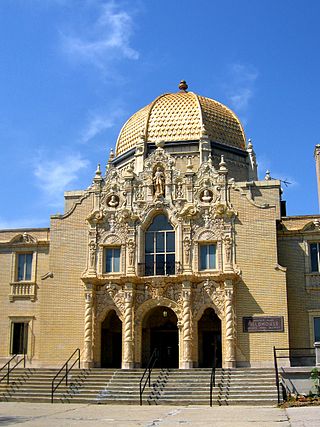
The West Side is one of the three major sections of the city of Chicago, Illinois, U.S. The other two sections within Chicago that associate with the West Side are the North Side and the South Side. The West Side consists of communities that are of historical, cultural, and ideological importance to the history and development of Chicago. On the flag of Chicago, the West Side is represented by the central white stripe.
Gentrification, the process of altering the demographic composition of a neighborhood usually by decreasing the percentage of low-income minority residents and increasing the percentage of typically white, higher-income residents, has been an issue between the residents of minority neighborhoods in Chicago who believe the influx of new residents destabilizes their communities, and the gentrifiers who see it as a process that economically improves a neighborhood. Researchers have debated the significance of its effects on the neighborhoods and whether or not it leads to the displacement of residents. There are some researchers who claim that the loss of affordable housing mainly impacts the poorer minority residents and causes them to have to move out of their neighborhoods which destabilizes their cultural communities. However, critics say that since gentrification often excludes highly black neighborhoods, those residents are prevented from benefiting from any of the positive effects such as redevelopment and neighborhood investment. Factors associated with and used to measure gentrification in Chicago are changes in the number of residents with bachelor's degrees, median household income, racial composition, visual observations, and the presence of coffee shops. Historically, the emergence of urban black and Latino neighborhoods in Chicago during the 1950s through the 1970s were made possible because of the waves of white residents moving out into more suburban neighborhoods. There have been phases of gentrification in Chicago of various neighborhoods, some of which were in 1990s and in 2007–2009. Gentrification debates in Chicago have been mostly focused around the gentrification of Chicago's historically Latino or black neighborhoods. Generally, these neighborhoods are located near the central urban downtown areas and along the east side of the city.
Dearborn Park is a residential Chicago neighborhood located in the Loop and Near South Side community areas of Chicago in Cook County, Illinois, United States. The area is known for its unique architecture, green spaces, and proximity to the city's downtown area and many cultural and recreational attractions. Early in Chicago history, this became an immigrant neighborhood before being ravaged by a fire in the 1870s, it was then bought up for railroad rights-of-way leading to Dearborn Station. When several rail-lines ceased service in the early 1970s, the trackage yards were themselves replaced and redeveloped into this neighborhood.
















